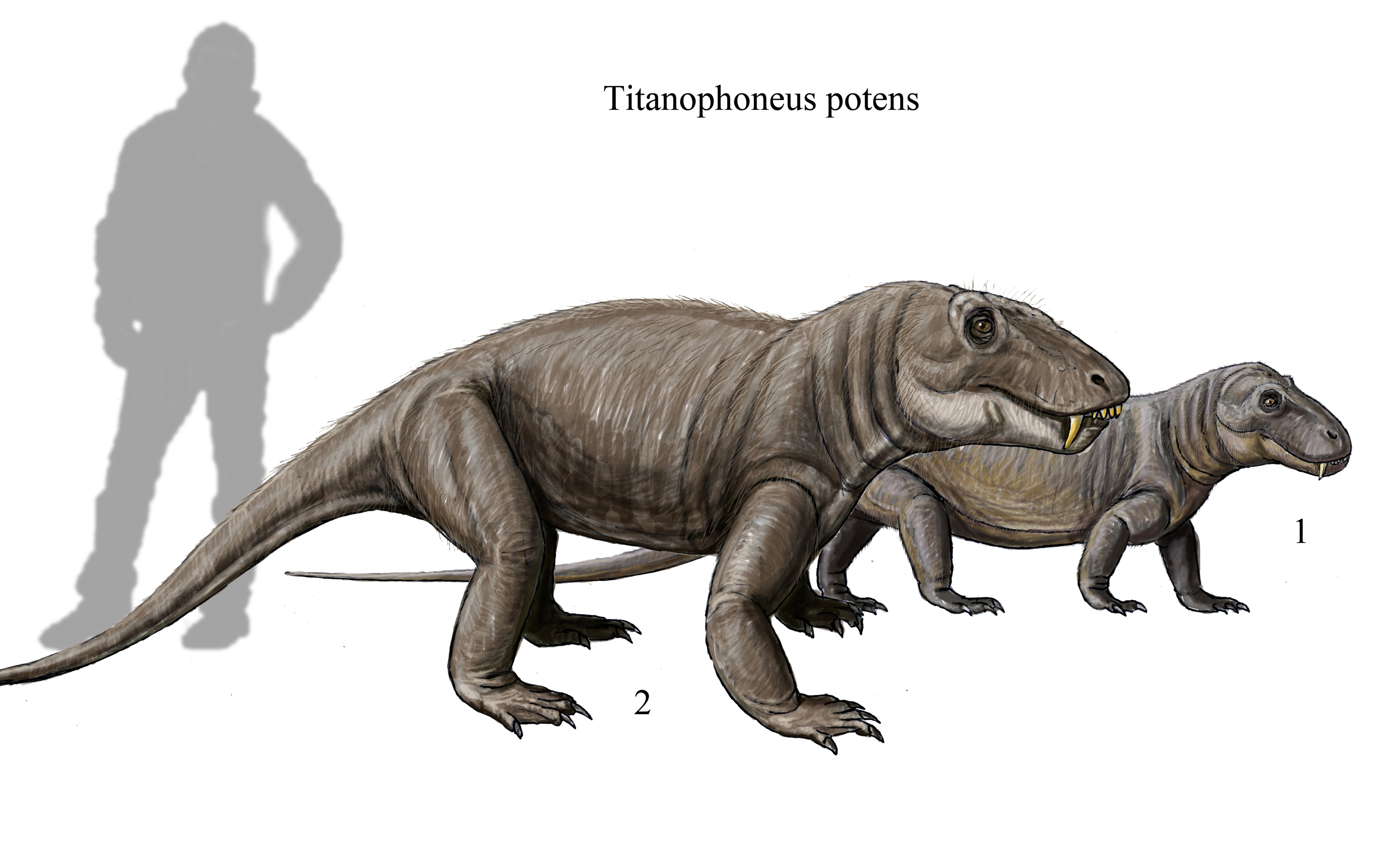|
Pachydectes
''Pachydectes'' is an extinct genus of biarmosuchian therapsids from the Middle Permian of South Africa known from a single skull. The etymology of the name ''Pachydectes'' is derived from the Greek word ''pakhus,'' meaning "thick" or "thickened", and ''dektes,'' meaning "biter". In conjunction this name is representative of the unique pachyostotic bone present above the maxillary canine tooth found in the skull of the specimen. There is only one known species within the genus, ''Pachydectes elsi'' which is named in honor of the person who discovered the fossil. The holotype and only known specimen was found just above the Ecca-Beaufort contact in the eastern Karoo basin, which was a fluvial depositional environment. As a member of the clade Biarmosuchia, ''Pachydectes'' retains many basal therapsid features, though with unique specializations one of which is the presence of adornments on the skull with horn-like protuberances. Also as a member of this clade Pachydectes is tho ... [...More Info...] [...Related Items...] OR: [Wikipedia] [Google] [Baidu] |
Biarmosuchian
Biarmosuchia is an extinct clade of non-mammalian synapsids from the Permian. Biarmosuchians are the most basal group of the therapsids. They were moderately-sized, lightly built carnivores, intermediate in form between basal sphenacodont "pelycosaurs" and more advanced therapsids. Biarmosuchians were rare components of Permian ecosystems, and the majority of species belong to the clade Burnetiamorpha, which are characterized by elaborate cranial ornamentation. Characteristics The biarmosuchian skull is very similar to the sphenacodontid skull, differing only in the larger temporal fenestra (although these are still small relative to later therapsids), slightly backward-sloping occiput (the reverse of the pelycosaur condition), reduced number of teeth, and single large canine teeth in both upper and lower jaws, and other features (Carroll 1988 pp. 370, Benton 2000 p. 114). In later specialised Biarmosuchia, these resemble the enlarged canines of the Gorgonopsia. The pr ... [...More Info...] [...Related Items...] OR: [Wikipedia] [Google] [Baidu] |
Bullacephalus
''Bullacephalus'' is an extinct genus of biarmosuchian therapsids belonging to the family Burnetiidae. The type species ''B. jacksoni'' was named in 2003. It is known from a relatively complete skull and lower jaw, discovered in the Late Permian Tapinocephalus Assemblage Zone of the Beaufort Group of South Africa. This genus of therapsida lived during the Late Permian period, approximately 250 million years ago. The name ''Bullacephalus'' comes from the Latin words "bullatus," meaning "bossed" or "knobbed," and "cephalus," meaning "head." This name refers to the distinctive bony knob on the top of the therapsid's skull, which contributes to the history of this genus. This stem based taxon includes ''Ictidorhinus'' or Hippasaurs. ''Bullacephalus'' can even be characterized as having "skull moderately to greatly pachyostotic; swollen boss present above the postorbital bar formed by the postfrontal and postorbital; deep linear sculpturing of the snout; exclusion of the jugal from ... [...More Info...] [...Related Items...] OR: [Wikipedia] [Google] [Baidu] |
Middle Permian
The Guadalupian is the second and middle series/epoch of the Permian. The Guadalupian was preceded by the Cisuralian and followed by the Lopingian. It is named after the Guadalupe Mountains of New Mexico and Texas, and dates between 272.95 ± 0.5 – 259.1 ± 0.4 Mya. The series saw the rise of the therapsids, a minor extinction event called Olson's Extinction and a significant mass extinction called the end-Capitanian extinction event. The Guadalupian is also known as the Middle Permian. Name and background The Guadalupian is the second and middle series or epoch of the Permian. Previously called Middle Permian, the name of this epoch is part of a revision of Permian stratigraphy for standard global correlation. The name "Guadalupian" was first proposed in the early 1900s, and approved by the International Subcommission on Permian Stratigraphy in 1996. References to the Middle Permian still exist. The Guadalupian was preceded by the Cisuralian and followed by the Lopingian. ... [...More Info...] [...Related Items...] OR: [Wikipedia] [Google] [Baidu] |
Herbivore
A herbivore is an animal anatomically and physiologically evolved to feed on plants, especially upon vascular tissues such as foliage, fruits or seeds, as the main component of its diet. These more broadly also encompass animals that eat non-vascular autotrophs such as mosses, algae and lichens, but do not include those feeding on decomposed plant matters (i.e. detritivores) or macrofungi (i.e. fungivores). As a result of their plant-based diet, herbivorous animals typically have mouth structures ( jaws or mouthparts) well adapted to mechanically break down plant materials, and their digestive systems have special enzymes (e.g. amylase and cellulase) to digest polysaccharides. Grazing herbivores such as horses and cattles have wide flat- crowned teeth that are better adapted for grinding grass, tree bark and other tougher lignin-containing materials, and many of them evolved rumination or cecotropic behaviors to better extract nutrients from plants. A larg ... [...More Info...] [...Related Items...] OR: [Wikipedia] [Google] [Baidu] |
Weathering
Weathering is the deterioration of rocks, soils and minerals (as well as wood and artificial materials) through contact with water, atmospheric gases, sunlight, and biological organisms. It occurs '' in situ'' (on-site, with little or no movement), and so is distinct from erosion, which involves the transport of rocks and minerals by agents such as water, ice, snow, wind, waves and gravity. Weathering processes are either physical or chemical. The former involves the breakdown of rocks and soils through such mechanical effects as heat, water, ice and wind. The latter covers reactions to water, atmospheric gases and biologically produced chemicals with rocks and soils. Water is the principal agent behind both kinds, though atmospheric oxygen and carbon dioxide and the activities of biological organisms are also important. Biological chemical weathering is also called biological weathering. The materials left after the rock breaks down combine with organic material to create so ... [...More Info...] [...Related Items...] OR: [Wikipedia] [Google] [Baidu] |
Fossilized
A fossil (from Classical Latin , ) is any preserved remains, impression, or trace of any once-living thing from a past geological age. Examples include bones, shells, exoskeletons, stone imprints of animals or microbes, objects preserved in amber, hair, petrified wood and DNA remnants. The totality of fossils is known as the ''fossil record''. Though the fossil record is incomplete, numerous studies have demonstrated that there is enough information available to give a good understanding of the pattern of diversification of life on Earth. In addition, the record can predict and fill gaps such as the discovery of '' Tiktaalik'' in the arctic of Canada. Paleontology includes the study of fossils: their age, method of formation, and evolutionary significance. Specimens are sometimes considered to be fossils if they are over 10,000 years old. The oldest fossils are around 3.48 billion years to 4.1 billion years old. Early edition, published online before print. The ... [...More Info...] [...Related Items...] OR: [Wikipedia] [Google] [Baidu] |
Gondwana
Gondwana ( ; ) was a large landmass, sometimes referred to as a supercontinent. The remnants of Gondwana make up around two-thirds of today's continental area, including South America, Africa, Antarctica, Australia (continent), Australia, Zealandia, Arabian Peninsula, Arabia, and the Indian subcontinent. Gondwana was formed by the Accretion (geology), accretion of several cratons (large stable blocks of the Earth's crust), beginning with the East African Orogeny, the collision of India and Geography of Madagascar, Madagascar with East Africa, and culminating in with the overlapping Brasiliano orogeny, Brasiliano and Kuunga orogeny, Kuunga orogenies, the collision of South America with Africa, and the addition of Australia and Antarctica, respectively. Eventually, Gondwana became the largest piece of continental crust of the Paleozoic Era, covering an area of some , about one-fifth of the Earth's surface. It fused with Laurasia during the Carboniferous to form Pan ... [...More Info...] [...Related Items...] OR: [Wikipedia] [Google] [Baidu] |
Shale
Shale is a fine-grained, clastic sedimentary rock formed from mud that is a mix of flakes of Clay mineral, clay minerals (hydrous aluminium phyllosilicates, e.g., Kaolinite, kaolin, aluminium, Al2Silicon, Si2Oxygen, O5(hydroxide, OH)4) and tiny fragments (silt-sized particles) of other minerals, especially quartz and calcite.Blatt, Harvey and Robert J. Tracy (1996) ''Petrology: Igneous, Sedimentary and Metamorphic'', 2nd ed., Freeman, pp. 281–292 Shale is characterized by its tendency to split into thin layers (Lamination (geology), laminae) less than one centimeter in thickness. This property is called ''Fissility (geology), fissility''. Shale is the most common sedimentary rock. The term ''shale'' is sometimes applied more broadly, as essentially a synonym for mudrock, rather than in the narrower sense of clay-rich fissile mudrock. Texture Shale typically exhibits varying degrees of fissility. Because of the parallel orientation of clay mineral flakes in shale, it breaks in ... [...More Info...] [...Related Items...] OR: [Wikipedia] [Google] [Baidu] |
Fluvial Processes
In geography and geology, fluvial sediment processes or fluvial sediment transport are associated with rivers and streams and the Deposition (geology), deposits and landforms created by sediments. It can result in the formation of ripple marks, ripples and dunes, in fractal-shaped patterns of erosion, in complex patterns of natural river systems, and in the development of floodplains and the occurrence of flash floods. Sediment moved by water can be larger than sediment moved by air because water has both a higher density and viscosity. In typical rivers the largest carried sediment is of sand and gravel size, but larger floods can carry Cobble (geology), cobbles and even boulders. When the stream or rivers are associated with glaciers, ice sheets, or ice caps, the term ''glaciofluvial'' or Fluvioglacial landform, ''fluvioglacial'' is used, as in periglacial flows and glacial lake outburst floods. Fluvial sediment processes include the sediment transport, motion of sediment and ero ... [...More Info...] [...Related Items...] OR: [Wikipedia] [Google] [Baidu] |
Mudstone
Mudstone, a type of mudrock, is a fine-grained sedimentary rock whose original constituents were clays or muds. Mudstone is distinguished from ''shale'' by its lack of fissility.Blatt, H., and R.J. Tracy, 1996, ''Petrology.'' New York, New York, W. H. Freeman, 2nd ed, 529 pp. The term ''mudstone'' is also used to describe carbonate rocks (limestone or dolomite) that are composed predominantly of carbonate mud. However, in most contexts, the term refers to siliciclastic mudstone, composed mostly of silicate minerals. The NASA Curiosity rover has found deposits of mudstone on Mars that contain organic substances such as propane, benzene and toluene. Definition There is not a single definition of mudstone that has gained general acceptance,Boggs 2006, p.143 though there is wide agreement that mudstones are fine-grained sedimentary rocks, composed mostly of silicate grains with a grain size less than . Individual grains this size are too small to be distinguished without a micros ... [...More Info...] [...Related Items...] OR: [Wikipedia] [Google] [Baidu] |
The Anatomical Record
''The Anatomical Record'' is a peer-reviewed scientific journal covering anatomy. It was established by the American Association of Anatomists in 1906 and is published by John Wiley & Sons. According to the ''Journal Citation Reports'', the journal has a 2020 impact factor of 2.064. See also * List of biology journals This is a list of articles about scientific journals in biology and its various subfields. General Agriculture * Advances in Agronomy * '' Agriculture, Ecosystems & Environment'' * '' Agroecology and Sustainable Food Systems'' * ''Animal'' ... References External links * Anatomy journals Wiley (publisher) academic journals Publications established in 1906 Monthly journals English-language journals 1906 establishments in the United States {{biology-journal-stub ... [...More Info...] [...Related Items...] OR: [Wikipedia] [Google] [Baidu] |





